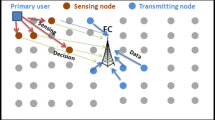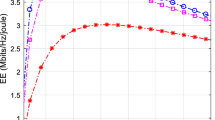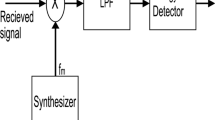Abstract
Cooperative spectrum sensing (CSS) is an efficient method to detect the reliability of the free spectrum, however, with great overhead and energy consumption. In this paper, we study a much broader application of CSS, where the sensors are used to sense multiple channels. On the one hand, since the tiny and low-cost sensors do not have high-speed analog-to-digital-convertors, they cannot simultaneously sense more than one channel. Therefore, the simultaneous multi-channel CSS is an important issue in a cognitive sensor network (CSN). On the other hand, these tiny sensors do not have high-power batteries, which makes the network lifetime as an important metric. In this paper, node selection is proposed for the multi-channel CSS to maximize the lifetime of a CSN under some detection constraints with lower overhead than cooperative sensing by all the sensors simultaneously. We analyze the problem for the OR and the AND rules, which can be implemented at the fusion center. The problem is solved by using convex optimization methods where assignment indices for every sensor are assumed. We provide a performance analysis through simulations using MATLAB, which shows that the sensor selection scheme provides a significant long lifetime for a CSN compared to the case where sensors are selected randomly and where all sensors are just classified to sense the channels simultaneously.












Similar content being viewed by others
Notes
This assumption does not have an effect on the proposed algorithm, and it can be extended to the other existing proper detectors, easily.
There are studies on the SNR estimation of nodes in spectrum sensing networks, but it is not the goal of this paper. Although the assumption seems unrealistic for some scenarios, it does not affect the proposed algorithm, and the algorithm steps can be done based on the average SNR or Packet Reception Ratio, similarly.
References
Ghasemi, A., & Sousa, S. (2008). Spectrum sensing in cognitive radio networks: Requirements, challenges and design trade-offs. IEEE Communications Magazine, 46(4), 32–39.
Akan, O. B., Karli, O. B., & Ergul, O. (2009). Cognitive radio sensor networks. IEEE Network, 23(4), 34–40.
Arora, N., & Mahajan, R. (2014). cooperative spectrum sensing using hard decision fusion scheme. International Journal of Engineering Research and General Science, 2(4), 36–43.
Ma, J., Guodong, Z., & Ye, L. (2008). Soft combination and detection for cooperative spectrum sensing in cognitive radio networks. IEEE Transactions on Wireless Communications, 7(11), 4502–4507.
Tri Do, N., & Beongku, A. (2015). A soft-hard combination-based cooperative spectrum sensing scheme for cognitive radio networks. Sensors, 15, 4388–4407.
Karthickeyan, R., & Vadivelu, R. (2014). Cooperative spectrum sensing and decision making rules for cognitive radio. International Journal of Innovative Research in Science, Engineering and Technology, 3(3), 1619–1623.
Farag, H. M., & Ehab, M. M. (2015). Hard decision cooperative spectrum sensing based on estimating the noise uncertainty factor. In 2015 tenth international conference on computer engineering & systems (ICCES), Cairo.
Maleki, S., Leus, G., Chatzinotas, S., & Ottersten, B. (2015). To AND or to OR: On energy-efficient distributed spectrum sensing with combined censoring and sleeping. IEEE Transactions on Wireless Communications, 14(8), 4508–4521.
Cichoń, K., Kliks, A., & Bogucka, H. (2016). Energy-efficient cooperative spectrum sensing: A survay. IEEE Communications Survey & Tutorials, 18(3), 1861–1886.
Najimi, M., Ebrahimzadeh, A., Hosseni Andargoli, S., & Fallahi, A. (2014). Lifetime maximization in cognitive sensor networks based on the node selection. IEEE Sensors Journal, 14(7), 2376–2383.
Jayaweera, S. K. (2015). Wideband spectrum sensing. In S. K. Jayaweera (Ed.), Signal processing for cognitive radios (pp. 323–376). John Wiley & Sons.
Hattab, G., & Ibnkahla, M. (2014). Multiband spectrum sensing: challenges and limitations. In Proceedings of WiSense workshop, Ottawa.
Sun, H., Nallanathan, A., Wang, C.-X., & Chen, Y. (2013). Wideband spectrum sensing for cognitive radio networks: A survey. IEEE Wireless Communications, 20(2), 74–81.
Soa, J., & Kwon, T. (2016). Limited reporting-based cooperative spectrum sensing for multiband cognitive radio networks. International Journal of Electronics and Communications (AEU), 70(4), 386–397.
Kaligineedi, P., & Bhargava, V. (2011). Sensor allocation and quantization schemes for multi-band cognitive radio cooperative sensing system. IEEE Transaction on Wireless Communications, 10(1), 284–293.
Jain, R. (2007). Channel model: Atutorial. In WiMAX forum AATG (Vol. 10), (pp. 1–27).
Najimi, M., Ebrahimzadeh, A., Hosseini Andargoli, S. M., & Fallahi, A. (2013). A novel sensing node and decision node selection method for energy efficiency of cooperative spectrum sensing in cognitive radio networks. IEEE Sensor Journal, 13(5), 1610–1621.
Noori, M., & Ardakani, M. (2011). Lifetime analysis of random event-driven clustered wireless sensor networks. IEEE Transactions on Mobile Computing, 10(10), 1448–1458.
Chen, Y., & Zhao, Q. (2005). On the lifetime of wireless sensor networks. IEEE Communication Letters, 9(11), 976–978.
Boyd, S., & Vanderberghe, L. (2004). Convex optimization. Cambridge University Press.
Han, D., & Lim, J. H. (2010). Smart home energy management system using IEEE 802.15.4 and zigbee. IEEE Transactions on Consumer Electronics, 56(3), 1403–1410.
Bagheri, A., Ebrahimzadeh, A., & Najimi, M. (2018). Sensor selection for extending lifetime of multi-channel cooperative sensing in cognitive sensor networks. Physical Communication, 26, 96–105.
Liu, X., Jia, M., Na, Z., Lu, W., & Li, F. (2017). Multi-modal cooperative spectrum sensing based on dempster–shafer fusion in 5G-based cognitive radio. IEEE Access, 6, 199–208.
Ren, J., Zhang, Y., Ye, Q., Yang, K., Zhang, K., & Shen, X. (2016). Exploiting secure and energy-efficient collaborative spectrum sensing for cognitive radio sensor networks. IEEE Transactions on Wireless Communications, 15(10), 6813–6827.
Hamdaoui, B., Khalfi, B., & Guizani, M. (2018). Compressed wideband spectrum sensing: Concept, challenges, and enablers. IEEE Communications Magazin, 56(4), 136–141.
Zheng, M., Chen, L., Liang, W., Yu, H., & Wu, J. (2017). Energy-efficiency maximization for cooperative spectrum sensing in cognitive sensor networks. IEEE Transactions on Green Communications and Networking, 1(1), 29–39.
Liu, X., Li, F., & Na, Z. (2017). Optimal resource allocation in simultaneous cooperative spectrum sensing and energy harvesting for multichannel cognitive radio. IEEE Access, 5, 3801–3812.
Liu, X., Jia, M., Zhang, X., & Lu, W. (2018). A novel multichannel Internet of things based on dynamic spectrum sharing in 5G communication. IEEE Internet of Things Journal, 6(4), 5962–5970.
Liu, X., & Zhang, X. (2018). Rate and energy efficiency improvements for 5G-based IoT with simultaneous transfer. IEEE Internet of Things Journal, 6(4), 5971–5980.
Awasthi, M., Nigam, M., & Kumar, V. (2020). Energy efficiency maximization by optimal fusion rule in frequency-flat-fading environment. AEU-International Journal of Electronics and Communications, 113, 152965.
Verma, P. (2020) Weighted fusion scheme for cooperative spectrum sensing. In IEEE international conference on industry 4.0 technology (I4Tech).
Olawole, A., Takawira, F., & Oyerinde, O. (2019). Fusion rule and cluster head selection scheme in cooperative spectrum sensing. IET Communications, 13(6), 758–765.
Yang, T., Wu, Y., Li, L., Xu, W., & Tan, W. (2019). Fusion rule based on dynamic grouping for cooperative spectrum sensing in cognitive radio. IEEE Access, 7, 51630–51639.
Bagheri, A., Ebrahimzadeh, A., & Najimi, M. (2020). Game-theory-based lifetime maximization of multi-channel cooperative spectrum sensing in wireless sensor networks. Wireless Networks, 26, 4705–4721.
Acknowledgements
The authors gratefully acknowledge the support of Babol Noshirvani University of Technology under Grant BNUT/925120015/94.
Author information
Authors and Affiliations
Corresponding author
Additional information
Publisher's Note
Springer Nature remains neutral with regard to jurisdictional claims in published maps and institutional affiliations.
Appendices
Appendix 1
Considering the Lagrange multipliers \({\uprho }_{\text{n}} ,{\uplambda }_{\text{m}} ,\,{\text{and}}\,{{\upxi }}_{\text{m}}\) for the constraints (20-1), (20-2), and (20-3), respectively, we form the Lagrange function as follows [33]:
Since we remove the selected nodes from the set of remained nodes, the constraints (20-4) and (20-5) are checked during the algorithm, therefore they are not considered in the Lagrange function. We can find the optimal values of \({\varphi }_{{{\text{m}},{\text{n}}}}^{*}\), by differentiating L with respect to \({\varphi }_{{{\text{m}},{\text{n}}}}\), as [33]:
Now, the priority of sensors to detect the m-th channel is calculated as:
To obtain the optimum values of Lagrange multipliers in (40), the complementary slackness conditions are analyzed. Because it is easy to track, we don’t repeat them and just use the results.
Appendix 2
Considering the Lagrange multipliers \({\uprho }_{\text{n}} ,{\uplambda }_{\text{m}} \,{\text{and}}\,{{\upxi }}_{\text{m}}\) for the constraints (21-1), (21-2), and (21-3), respectively, we form the Lagrange function as follows [33]:
Similarly, the constraints (21-5) and (21-4) are not inserted in the Lagrange function. We differentiate \({\text{L}}\) with respect to \({{\upvarphi }}_{{{\text{m}},{\text{n}}}}\), and the priority of the sensors is calculated as:
Also, the complementary slackness conditions are analyzed to find the optimum multipliers in (42).
Appendix 3
Lagrange function for the special case is formed as follows [33]:
The optimal value of \({{\upvarphi }}_{{{\text{m}},{\text{n}}}}^{ *}\) are calculated by differentiating \({\text{L}}\) with respect to \({{\upvarphi }}_{{{\text{m}},{\text{n}}}}\). Now, the sensors priority to detect the m-th channel, are calculated as:
The optimum values of Lagrange multipliers in (44) are calculated from analyzing the complementary slackness conditions [24]. Also, we check the number of the selected sensors, hence \({{\upxi }}_{\text{m}}\) is removed.
Appendix 4
Lagrange function for AND fusion rule in the CFP scenario is formed as [33]:
Now the priority of the sensors is calculated by differentiating \({\text{L}}\) with respect to \({{\upvarphi }}_{{{\text{m}},{\text{n}}}}\), as:
To obtain the optimum Lagrange multipliers, the complementary slackness conditions are analyzed [33].
Rights and permissions
About this article
Cite this article
Bagheri, A., Ebrahimzadeh, A. & Najimi, M. Fusion Rules Effects on Lifetime Maximization of Multi-channel Cooperative Spectrum Sensing. Wireless Pers Commun 119, 2197–2225 (2021). https://doi.org/10.1007/s11277-021-08326-1
Accepted:
Published:
Issue Date:
DOI: https://doi.org/10.1007/s11277-021-08326-1




